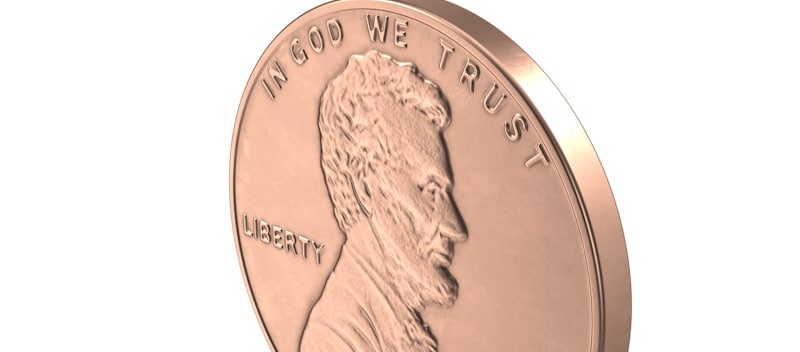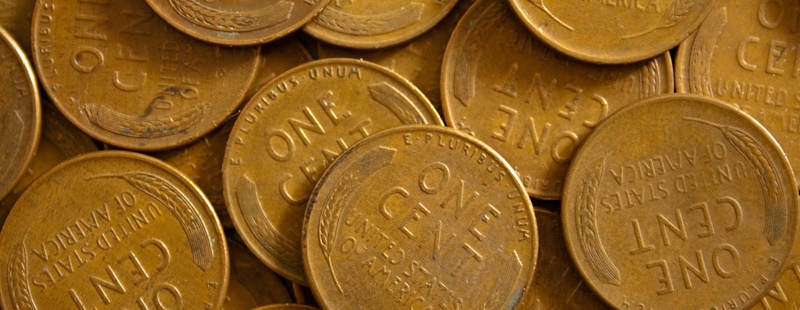The penny in use today resembles the 1935 Wheat penny in many aspects, although the 1935 coin is much more expensive. Collectors battle it out to get these coins because of their rarity and age. Since they are no longer being produced, fewer Lincoln pennies will always be available.
In good condition, a 1935 wheat penny without a mint mark is worth $0.15. The worth, in extremely good condition, is $0.25. The worth is approximately $0.50 in extremely good condition. Coins including an MS 60 rating cost $3 when they are uncirculated. MS 63 uncirculated coins cost about $5.
The 1935 wheat pennies are very desirable regardless of condition. The US Mint made copper Wheat pennies from 1909 until 1942. Even today, they are still being minted, but the materials in these coins have changed.

1935 D Penny
In 1935, the Denver mint struck 47,000,000 Lincoln pennies, making them widely available on the market today. For a piece of low grade, you should budget a moderate $0.05 to $0.10, whereas MS 65 pieces typically cost below $13. The only items that might be more expensive are those with a red finish, typically costing between $300 and $400.
The 1935 D RD MS 67+ penny set an auction record in 2018 when it sold for $4,080. A 1935 D Penny in normal condition is about 40 cents, according to CoinTrackers.com, but one in mint condition can be had for around $35.00. A 1935 D Penny in certified mint state grade could fetch up to $35 at auction, while one in Average Circulated condition is only worth about 40 cents.
There is no specific coin grading scale used to determine this pricing. Therefore, when we say "Averagely Circulated," we mean that it is in a condition comparable to other coins that were in circulation in 1935, and by "mint state," we mean that it has been awarded the MS+ grade by one of the leading coin grading firms.
1935 Wheat Penny
From 1909 to 1942, the US Mint created copper Lincoln cents; even though they are still being minted, the makeup of these coins has changed. The inexpensive but extremely collectible 1935 Lincoln penny can be purchased in poor grades for under two cents. The 1935 Penny's worth is merely a few bucks, for example, in the mint form because of the enormous mintage.
This attractive coin is a great choice for beginning collectors and those on a tight budget. The 1935 Lincoln penny's obverse features a layout similar to the current penny's. You will see a raised image of President Abraham Lincoln in the center; the 1935 Wheat penny is also called Lincoln Penny.
The coin's nickname "Wheat Penny" comes from these wheat stalks. Collectors are unduly concerned with the coin's condition for a 1935 Lincoln penny. These coins have experienced a great deal of deterioration and wear due to their age.
Uncirculated coins will be completely flawless and will have no discernible imperfections. These coins will look exactly as they looked on the date they were struck and will be free of any dents or scratches. These items will be in pristine condition.
Extremely Fine coins may contain one or two very little flaws, but they will otherwise seem nearly flawless. These coins are in good shape overall and are among the top pennies coins collectors desire to acquire. However, a grader can spot a single scratch or chip under close study.
A coin that achieves a Fine grade has been in circulation for a considerable time. On its faces, you can see some scratching caused by vigorous circulation and smoothness around the borders. Nevertheless, it will be possible to read the formal writing and images on these coins, for the most part.
A coin that receives the grade of "Good" has been used in circulation for most of its existence. These coins would be severely damaged because they are constantly changing hands. Collectors still find them to be highly attractive despite all of this damage.
The Philadelphia mint's 1935 Lincoln pennies are popular despite their antiquity, with 245,388,000 pieces struck. You may usually buy low-grade coins for about $0.07 to $0.7. However, you could budget between $1 and $10 for a specimen that is in mint condition.
On the present coin market, rare pennies with stunning red colors can fetch an astounding $6,000 in value. Since 2018, the highest-priced 1935 RD MS 68+ Wheat penny has maintained the auction record. One passionate collector spent $34,075 on it that year.
The final coin in the collection lacking struck proof coins was the 1935 Lincoln penny. The US Mint has made these collectible coins since 1936, with just a few years being skipped. The San Francisco mint produced exactly 38,702,000 Lincoln pennies in 1935.
Most of these coins are cheap and have a poor grade after many years in circulation. Regular pennies can range in price from $0.10 to $2 in circulated condition to $4 to $25 in mint condition. The price of coins with vivid red surfaces can reach about $6,000 for one rated MS67.
How Much Is A 1935 British Penny Worth
Britannia is seated, facing right, clutching a trident, and donning a helmet on the reverse of the 1935 British Penny. Her other hand is on a shield emblazoned with the Saint George Cross. Based on demand and supply in that specific condition of preservation, the retail value of a 1935 British penny can vary from £0.20 to above £15.
1935 Very Rare Error Wheat Penny No Mint Mark
The 1935 Wheat Penny has numerous errors that we will go through below. These errors are rare, and you should look out for them when you possess a 1935 Wheat Penny. Below are some of the errors.
Doubled Dies
This coin occurs just after the hub hits the die twice at various angles. For example, the 1935 double die Wheat Penny often features inscriptions on the back and duplication in Lincoln's eye. E PLURIBUS UNUM is doubled significantly on the back of the 1935 D doubled die Lincoln penny.
On the other hand, the 1935 S twofold die Lincoln penny is the only example. The reverse of the coin contains inscriptions and duplication on the wheat ears. These mistakes are uncommon in the local market, but their cost is predicted to be between $50 and $100.
BIE Liberty Error
On the coin's obverse, the BIE error is a tiny vertical die crack that resembles the letter I in the term "Liberty." Usually, it is struck between the letters B and E. Many coins with this flaw fetch between $5 and $15.
Die Breaks
You may see traces on the surface of a penny struck with an ancient, fractured die. Pieces with severe die breaks will cost extra, as predicted. In light of this, you could expect to pay anything between $3 and $100.

Off-Center Strike
This error occurs when the die or planchet is not properly aligned or centered. The least expensive coins have an average inaccuracy of less than 3 percent. $50 to $100 can be earned by those whose visible date is 50 percent off-center.
Clipped Planchets
A blank planchet may be left without needing a piece on edge if the cutting machine makes a mistake. As a result, the rim of the penny will have a curved cut. The average cost of a clipped planchet error is $10.
Final Thoughts
The 1935 Wheat Penny collection is a favorite among collectors because these exquisite coins are important markers of American history. The fact that you can purchase it for a reasonable price is the best of all. The 1935 Lincoln cent is a great choice for beginners and coin collectors on a tight budget because it is affordable in all grades.
Shawn Manaher loves to play with new toys and dive into new hobbies. As a serial entrepreneur, work definitely comes first but there is always room for hobbies.

![1935 Wheat Penny Coin Value: [Complete Collector's Guide]](https://hobbynation.net/wp-content/uploads/2022/08/1935-wheat-penny-value-720x405.jpg)